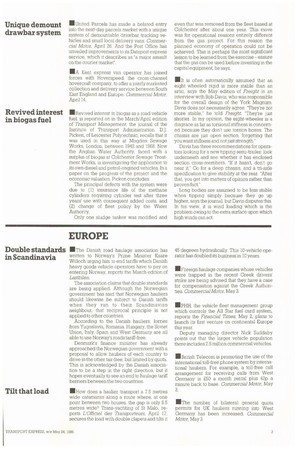Revived interest in biogas fuel
Page 29

If you've noticed an error in this article please click here to report it so we can fix it.
• Revived interest in biogas as a road vehicle fuel, is reported on in the March/April edition of Transport Management, the journal of the Institute of Transport Administration. DJ. Picken, of Leicester Polytechnic, recalls that it was used in this way at Mogden Sewage Works, London, between 1942 and 1968. Now the Anglian Water Authority, faced with a surplus of biogas at Colchester Sewage Treatment Works, is investigating the application to its own diesel and petrol-engined vehicles. In a paper on the progress of the project and the economic valuation, Picken concludes The principal defects with the system were due to (1) insurance life of the methane cylinders requiring cylinder test after three years use with consequent added costs, and (2) change of fleet policy by the Water Authority. Only one sludge tanker was modified and even that was removed from the fleet based at Colchester after about one year. This move was for operational reasons entirely different from the gas project. For this reason the planned economy of operation could not be achieved. This is perhaps the most significant lesson to be learned from the exercise ensure that the gas can be used before investing in the capital equipment, he says.
lilt is often automatically assumed that an eight wheeled rigid is more stable than an artic, says the May edition of Freight in an interview with Bob Davis, who was responsible for the overall design of the York Magnum. Davis does not necessarily agree. "They're not more stable," he told Freight. "They're just shorter. In my opinion, the eight-wheeler is a disgrace as far as torsional stiffness is concerned because they don't use torsion boxes. The chassis are just open section, forgetting that you want stiffness and not just strength." Davis has three recommendations for operators looking for a new tipping semi-trailer: look underneath and see whether it has enclosed section cross-members If it hasn't, don't go near it." Go for a deep chassis, and a tri-axle specification to give stability at the rear. "After that, you get into matters of opinion rather than proven fact." Long bodies are assumed to be less stable when tipping simply because they go up higher, says the journal, but Davis disputes this. In his view, it is wind loading which is the problem owing to the extra surface upon which high winds can act.














































































